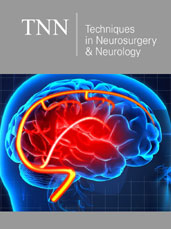- Submissions

Full Text
Techniques in Neurosurgery & Neurology
Surgical Anatomy of the Translabyrinthine Approach to The Vestibular Schwannomas
Behzad Saberi*
Medical Research, Iran
*Corresponding author: Behzad Saberi, Medical Research, Esfahan, Iran
Submission: July 13, 2018;Published: August 29, 2019

ISSN 2637-7748
Volume2 Issue4
Mini Review
Retrosigmoid, subtemporal, occipital and translabyrinthine approaches can be used to reach the vestibular schwannomas. Direct approach to the CP-Angle and cerebellum with minimum retraction and the possibility of lifting the tumor away from the brainstem without causing pressure on the cerebellum and brainstem, are the most advantages of using translabyrinthine approach. If the tumor would be small, it can be removed by this approach and in case the tumor would be large, the translabyrinthine approach allows direct access to the center of the tumor and after the central debulking of the tumor, it would collapse. Complete tumor removal and facial nerve preservation can be achieved by this approach since translabyrinthine approach allows exposing the lateral end of the internal auditory meatus and finding the facial nerve while entering the fallopian canal.
Since in translabyrinthine approach the labyrinth would be destroyed, the hearing would be destroyed either so it is not an appropriate approach in case the hearing preservation would be needed. In case the tumor would be larger than two centimeters, hearing preservation would almost be impossible. With the history of previous active otitis media, another approach should be selected. In case there would be a mastoid cavity, before using translabyrinthine approach, external auditory canal blind sac closure for complete obliteration, should be done and healed. Translabyrinthine approach is a lengthy procedure in comparison with middle fossa or suboccipital approaches. In case this approach can be done by two surgeons, the procedure would be easier.
The origin of the vestibular schwannomas usually would be in the internal auditory canal from one of the vestibular nerves. The location of the facial nerve vary since it would be displaced in the canal but it can be detected in a lateral position in the canal. Translabyrinthine approach is done by an opening in the temporal bone. Tympanic antrum connects the air cells of the mastoid part of the temporal bone with the middle ear. The bone removal is done between the external canal of the ear and the sinus of sigmoid which its location is in the sigmoid sulcus. The antrum’s communication with the tympanic cavity is done above the lateral semicircular canal’s prominence. The facial canal’s genu is located inferior to the lateral semicircular canal. Superior petrosal sinus can be exposed in the dural duplex by bone removing in the sinodural angle. The landmark which shows the labyrinth location would be the lateral semicircular canal. The vestibule would be opened after semicircular canal’s removal. The seventh cranial nerve’s entrance to the fallopian canal would be done in an anterior position to the superior vestibular nerve. This nerve is separated from facial nerve by the vestibular crest.
By CP-Angle exposure, the relevant cranial nerves and vessels can be seen. Trigeminal nerve exists near the cerebellum on the pontine surface. Anterior and superior to the flocculus would be the exit of the vestibulocochlear nerve. Abducens, facial and vestibulocochlear nerves exits, are located on the medulla oblongata where the area of entry for abducens nerve is in its anterior side. Abducens nerve then enters the dorello canal by a superior direction in the anterior side of the pons. PICA’s loop formations extend to the vestibulocochlear and glossopharyngeal nerves level in a cranial direction. Subarcuate and labyrinthine arteries extend from AICA’s loop which this loop protrudes into or against the internal auditory canal. PICA emerges from vertebral artery while the basilar artery would be the origin of the AICA. However the CP-Angle blood vessels show more anatomical variabilities than the its nerves. Having knowledge about the anatomy of these nerves and blood vessels, makes the translabyrinthine approach more practical and useful to access the CP-Angle and its pathologies [1-10].
References
- Rhoton Jr AL, Tedeschi H (1992) Microsurgical anatomy of acoustic neuroma. Otolaryngol Clin North Am 25(2): 257-294.
- Day JD, Chen DA, Arriaga M (2004) Translabyrinthine approach for acoustic neuroma. Neurosurgery 54(2): 391-395.
- Tos M, Thomsen J (1991) Translabyrinthine acoustic neuroma surgery: A surgical manual. Georg Thieme, Stuttgart, Germany.
- Mass SC, Wiet RJ, Dinces E (1999) Complications of the translabyrinthine approach for the removal of acoustic neuromas. Arch Otolaryngol Head Neck Surg 125(7): 801-804.
- Sterkers JM, Corlieu C, Sterkers O (1992) Acoustic neuroma surgery (1300 cases), the translabyrinthine method. In: Tos M, Thomsen J (Eds.), Acoustic Neuroma. Kugler, Amsterdam, Netherlands, pp. 377-378.
- King TT, Morrison AW (1980) Translabyrinthine and transtentorial removal of acoustic tumours: results of 150 cases. J Neurosurg 52(2): 210-216.
- Sterkers JM (1989) Life-threatening complications and severe neurologic sequelae in surgery of acoustic neurinoma. Ann Otolaryngol Chir Cervicofac 106(4): 245-250.
- Briggs RJS, Fabinyi G, Kaye AH (2000) Current management of acoustic neuromas: review of surgical approaches and outcomes. J Clin Neurosci 7(6): 521-526.
- House WF, Hitselberger WE (1979) Translabyrinthine approach. In: House WF, Leutje CM (Eds.), Acoustic Tumors. University Park Press, Baltimore, USA, pp. 43-87.
- Benecke JE (1989) Complications of acoustic tumor surgery and their management. Semin Hear 10: 341-345.
© 2018 Behzad Saberi. This is an open access article distributed under the terms of the Creative Commons Attribution License , which permits unrestricted use, distribution, and build upon your work non-commercially.
 a Creative Commons Attribution 4.0 International License. Based on a work at www.crimsonpublishers.com.
Best viewed in
a Creative Commons Attribution 4.0 International License. Based on a work at www.crimsonpublishers.com.
Best viewed in 







.jpg)






























 Editorial Board Registrations
Editorial Board Registrations Submit your Article
Submit your Article Refer a Friend
Refer a Friend Advertise With Us
Advertise With Us
.jpg)






.jpg)














.bmp)
.jpg)
.png)
.jpg)










.jpg)






.png)

.png)



.png)






